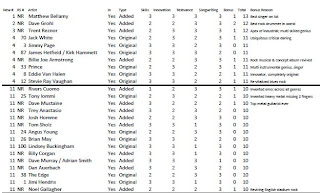Rolling Stone magazine compiles “top lists”. Their top lists used to be very bad; they seemed to solely represent the personal preferences of their editor. Recently the lists have gotten better as they use a “panel” of musicians and critics to select which is an improved system. And in any list, there is a lot of judgement, and should be a little fun.
Even with these improvements, in my opinion, Rolling Stone botched the Top 100 Guitarist list. The list is far too tilted to the past; their #1 guitarist, Jimi Hendrix, DIED OVER FORTY YEARS AGO. Thus my methodology includes “relevance” in the calculation, and someone who died over forty years ago, correspondingly scores lower. I read through the list carefully, consulted outside sources, reviewed my own music, and built a “methodology” that resulted in my own list.
Alternative Methodology:
In reading through the list Rolling Stone and the musicians doing the evaluations obviously employed a lot of criteria. This isn’t the “most talented” list, or we’d be looking at Steve Vai and John Petrucci as #1 and #2, but they don’t make the Rolling Stone(nor mine)list at all. Rather than use a “subjective” evaluation criteria, I made my own up, and made it more explicit.
– Skills – ranked 1-3, with Neil Young a 1 and Eddie Van Halen a 3
– Innovation – ranked 1-3, with Jimi Hendrix a 3 and Nick Mars a 1
– Relevance – ranked 1-3, with Dave Grohl a 3 and Hendrix a 1
– Songwriting – ranked 1-3, with Neil Young a 3 and Yngwie Malmsteen a 1
– “Bonus” – an arbitrary category I added which allows for 0-2 points to be added for outsized contributions beyond the above categories. Dave Grohl gets 2 points for being the best rock drummer in the entire world; Matthew Bellamy gets 1 point for being the best singer on the entire list
In the process you were either a “top 100” guitarist or you weren’t; then I started scoring the methodology on the top 100. Then I looked at the results and seemed if they made sense, and adjusted the scores accordingly.
Results of the Analysis:
As a result, the list I came up with is dramatically different than the Rolling Stone list, since it doesn’t just contain dead blues or rockabilly musicians and it weighs newer contributions higher than what happened 40+ years ago.
– only 46 of the 100 guitarists on the RS 100 list made the adjusted list
– 4 of the top 10 in the adjusted list weren’t even ranked in the Top 100 by RS
– 13 of the top 25 guitarists in the adjusted list weren’t even ranked in the Top 100 by RS
Read more

